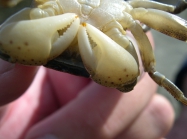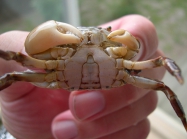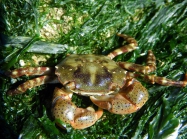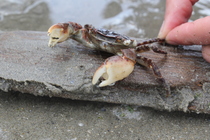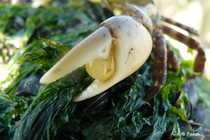
| Intro | | Search taxa | | Browse taxa | | Distributions | | Terminology | | References | | Statistics | | Online sources | | Tutorial | | Log in |
WoRMS taxon detailsHemigrapsus sanguineus (De Haan, 1835)
158417 (urn:lsid:marinespecies.org:taxname:158417)
accepted
Species
Grapsus (Grapsus) sanguineus De Haan, 1835 · unaccepted > superseded combination
Heterograpsus maculatus H. Milne Edwards, 1853 · unaccepted > junior subjective synonym
Heterograpsus sanguineus (De Haan, 1835) · unaccepted > superseded combination
marine,
recent only
(of Grapsus (Grapsus) sanguineus De Haan, 1835) De Haan, W. (1833–1850). Crustacea. <em>In: von Siebold, P.F., Fauna Japonica sive Descriptio Animalium, quae in Itinere per Japoniam, Jussu et Auspiciis Superiorum, qui Summum in India Batava Imperium Tenent, Suspecto, Annis 1823-1830 Collegit, Notis, Observationibus et Adumbrationibus Illustravit.</em> i–xxxi, ix–xvi, 1–243, pls. A–J, L–Q, 1–55. Lugduni-Batavorum. [Dates of publication per Holthuis, 1953: 1833 (ix–xvi, De Haan's "Praemissa" & "Expositio"; 1–24, pls. 1–8, A, B, circ. 2), 1835 (25–64, pls. 9–15, 17, C, D), 1837 (65–72, pls. 16, 18–24, E, F), 1839 (73–108, pls. 25–32, G, H), 1841 (109–164, pls. 33–37, 39–42, 47), 1844 (pls. 38, 43–46, 48, 51–55, I–N), 1849 (165–196, 197–243, pls. 49, 50 O–Q), 1849 (i–xxxi, De Haan's "Praefatio"), 1850 (vii–xvii, Von Siebold's "Commentatio")).
page(s): 58(113 pdf) [details]
Distribution Exotic species found from North Carolina to Isle au Haut, Maine.
Distribution Exotic species found from North Carolina to Isle au Haut, Maine. [details]
DecaNet eds. (2024). DecaNet. Hemigrapsus sanguineus (De Haan, 1835). Accessed through: World Register of Marine Species at: https://www.marinespecies.org/aphia.php?p=taxdetails&id=158417 on 2024-10-31
Date action by
original description
(of Grapsus (Grapsus) sanguineus De Haan, 1835) De Haan, W. (1833–1850). Crustacea. <em>In: von Siebold, P.F., Fauna Japonica sive Descriptio Animalium, quae in Itinere per Japoniam, Jussu et Auspiciis Superiorum, qui Summum in India Batava Imperium Tenent, Suspecto, Annis 1823-1830 Collegit, Notis, Observationibus et Adumbrationibus Illustravit.</em> i–xxxi, ix–xvi, 1–243, pls. A–J, L–Q, 1–55. Lugduni-Batavorum. [Dates of publication per Holthuis, 1953: 1833 (ix–xvi, De Haan's "Praemissa" & "Expositio"; 1–24, pls. 1–8, A, B, circ. 2), 1835 (25–64, pls. 9–15, 17, C, D), 1837 (65–72, pls. 16, 18–24, E, F), 1839 (73–108, pls. 25–32, G, H), 1841 (109–164, pls. 33–37, 39–42, 47), 1844 (pls. 38, 43–46, 48, 51–55, I–N), 1849 (165–196, 197–243, pls. 49, 50 O–Q), 1849 (i–xxxi, De Haan's "Praefatio"), 1850 (vii–xvii, Von Siebold's "Commentatio")).
page(s): 58(113 pdf) [details] original description (of Heterograpsus maculatus H. Milne Edwards, 1853) Milne Edwards, H. (1853). Mémoire sur la famille des ocypodiens. <em>Annales des Sciences Naturelles, 3rd series.</em> 20: 163-228, pls. 6-11. [details] context source (Introduced species) Katsanevakis, S.; Bogucarskis, K.; Gatto, F.; Vandekerkhove, J.; Deriu, I.; Cardoso A.S. (2012). Building the European Alien Species Information Network (EASIN): a novel approach for the exploration of distributed alien species data. <em>BioInvasions Records.</em> 1: 235-245., available online at http://easin.jrc.ec.europa.eu [details] Available for editors context source (HKRMS) Fong, C. W. (1998). Some aspects of the ecology of the seagrass Zostera japonica in Hong Kong. <em>MPhil thesis. The University of Hong Kong.</em> [details] context source (Schelde) (2010). Bedreiging voor biodiversiteit. Indicatoren voor het Schelde-estuarium. <em>Opgemaakt in opdracht van Afdeling Maritieme Toegang, projectgroep EcoWaMorSe, Vlaams Nederlandse Scheldecommissie. VLIZ Information Sheets, 200. Vlaams Instituut voor de Zee (VLIZ): Oostende.</em> 7 pp. (look up in IMIS) [details] additional source Muller, Y. (2004). Faune et flore du littoral du Nord, du Pas-de-Calais et de la Belgique: inventaire. [Coastal fauna and flora of the Nord, Pas-de-Calais and Belgium: inventory]. <em>Commission Régionale de Biologie Région Nord Pas-de-Calais: France.</em> 307 pp., available online at http://www.vliz.be/imisdocs/publications/145561.pdf [details] additional source Streftaris, N., A. Zenetos & E. Papathanassiou. (2005). Globalisation in marine ecosystems: the story of non-indigenous marine species across European seas. <em>Oceanogry and Marine Biology: an Annual Review.</em> 43: 419-453. (look up in IMIS) [details] Available for editors additional source Zenetos, A.; Çinar, M.E.; Pancucci-Papadopoulou, M.A.; Harmelin, J.-G.; Furnari, G.; Andaloro, F.; Bellou, N.; Streftaris, N.; Zibrowius, H. (2005). Annotated list of marine alien species in the Mediterranean with records of the worst invasive species. <em>Mediterranean Marine Science.</em> 6 (2): 63-118., available online at https://www.researchgate.net/publication/273213810_Annotated_list_of_marine_alien_species_in_the_Mediterranean_with_records_of_the_worst_invasive_species [details] Available for editors additional source Liu, J.Y. [Ruiyu] (ed.). (2008). Checklist of marine biota of China seas. <em>China Science Press.</em> 1267 pp. (look up in IMIS) [details] Available for editors additional source Zenetos, A.; Gofas, S.; Verlaque, M.; Cinar, M.; Garcia Raso, J.; Bianchi, C.; Morri, C.; Azzurro, E.; Bilecenoglu, M.; Froglia, C.; Siokou, I.; Violanti, D.; Sfriso, A.; San Martin, G.; Giangrande, A.; Katagan, T.; Ballesteros, E.; Ramos-Espla, A.; Mastrototaro, F.; Ocana, O.; Zingone, A.; Gambi, M.; Streftaris, N. (2010). Alien species in the Mediterranean Sea by 2010. A contribution to the application of European Union's Marine Strategy Framework Directive (MSFD). Part I. Spatial distribution. <em>Mediterranean Marine Science.</em> 11(2): 381-493., available online at https://doi.org/10.12681/mms.87 [details]  Present Present  Present in aphia/obis/gbif/idigbio Present in aphia/obis/gbif/idigbio  Inaccurate Inaccurate  Introduced: alien Introduced: alien  Containing type locality Containing type locality
From regional or thematic species database
Introduced species abundance in Black Sea (IHO Sea Area) : One specimen was collected from a yacht harbor in Constanta, Romania, on the Black Sea. [details]Introduced species abundance in Croatian part of the Adriatic Sea : A single specimen was found in Croatia (Schubart 2003). [details] Introduced species abundance in Italy (Nation) : According to personal communications from Italian scientists to Greg Ruiz, this crab is established near the Po River Delta. [details] Introduced species abundance in Romanian part of the Black Sea : One specimen was collected from a yacht harbor in Constanta, Romania, on the Black Sea. [details] Introduced species abundance in North Sea (IHO Sea Area) : Common [details] Introduced species abundance United States part of the North Atlantic Ocean (Marine Region) Dominant: We found that the range of H. sanguineus had extended northward since 2005, that population density had increased substantially (at least 10-fold at all sites), and that Asian shore crabs had become the dominant intertidal crab species in New Hampshire and southern Maine. [details] Introduced species abundance in Dutch part of the North Sea : Common [details] Introduced species abundance in French part of the English Channel (Marine Region) : Common [details] Introduced species abundance in French part of the English Channel (Marine Region) : Locally common [details] Introduced species abundance in French part of the North Atlantic Ocean (Marine Region) : Common to dominant [details] Introduced species abundance in French part of the North Sea (Marine Region) : Common [details] Introduced species impact in French part of the English Channel (Marine Region) : Other impact - undefined or uncertain [details] Introduced species impact in Romanian part of the Black Sea : Outcompetes native species for resources and/or space [details] Introduced species impact United States part of the North Atlantic Ocean (Marine Region) Consumes native species (predator or herbivore) [details] Introduced species impact United States part of the North Atlantic Ocean (Marine Region) Other impact - undefined or uncertain We found that while the presence of native mud crabs did not significantly influence the succession of fouling communities compared to caged and uncaged controls, the presence of introduced H. sanguineus reduced the biomass of native tunicates (particularly Molgula manhattensis), relative to caged controls. Moreover, the presence of H. sanguineus favored fouling communities dominated by introduced tunicates (especially Botrylloides violaceous and Diplosoma listerianum). [details] Introduced species impact German part of the North Sea (Marine Region) Outcompetes native species for resources and/or space [details] Introduced species impact in French part of the English Channel (Marine Region) : Other impact - undefined or uncertain [details] Introduced species impact in French part of the English Channel (Marine Region) : Outcompetes native species for resources and/or space [details] Introduced species impact in French part of the North Atlantic Ocean (Marine Region) : Outcompetes native species for resources and/or space [details] Introduced species impact in French part of the North Sea (Marine Region) : Outcompetes native species for resources and/or space [details] Introduced species impact in Celtic Sea (IHO Sea Area) : Other impact - undefined or uncertain [details] Introduced species population trend in Black Sea (IHO Sea Area) : Reproduction here is unlikely, because of the low salinity (~ 18 PSU) (Micu et al. 2010). [details] Introduced species population trend in Romanian part of the Black Sea : Reproduction here is unlikely, because of the low salinity (~ 18 PSU) (Micu et al. 2010). [details] Introduced species population trend in French part of the English Channel (Marine Region) : Increasing [details] Introduced species population trend in French part of the North Atlantic Ocean (Marine Region) : Increasing [details] Introduced species population trend in French part of the North Sea (Marine Region) : Increasing [details] Introduced species remark In French part of the English Channel (Marine Region) : In future, may present threat to shellfish farms and aquaculture production [details] Introduced species remark United States part of the North Atlantic Ocean (Marine Region) Our results show that the nonindigenous Asian crab has a greater reproductive potential than the native mud crab as evidenced by a longer breeding season, multiple brood production and higher fecundity rates. [details] Introduced species remark United States part of the North Atlantic Ocean (Marine Region): The high feeding rates but lack of a competitive advantage for H. sanguineus make it an unlikely but potentially impactful invader in the northeast Pacific. [details] Introduced species remark United States part of the North Atlantic Ocean (Marine Region) Here we demonstrated that the pattern of C. maenas displacement from rocky intertidal habitats observed in studies from Southern New England has continued as H. sanguineus populations have expanded northwards, which, given their high abundances, could result in greater disturbance to native communities (Lohrer and Whitlatch 2002a). [details] Introduced species vector dispersal in Belgian part of the North Sea: Ships: accidental with ballast water, sea water systems, live wells or other deck basins [details] Introduced species vector dispersal in Belgian part of the North Sea: Aquaculture: accidental [details] Introduced species vector dispersal in Belgian part of the North Sea: Aquaculture: accidental [details] Introduced species vector dispersal in Dutch part of the North Sea : Ships: accidental with ballast water, sea water systems, live wells or other deck basins [details] Introduced species vector dispersal in North Sea (IHO Sea Area) : Ships: accidental associated with cargo [details] Introduced species vector dispersal in French part of the English Channel (Marine Region) : Ships: accidental with ballast water, sea water systems, live wells or other deck basins [details] Introduced species vector dispersal in Black Sea (IHO Sea Area) : Ships: accidental with ballast water, sea water systems, live wells or other deck basins Ballast water is the most likely vector for its initial introduction, though ship/boat fouling and natural dispersal of larvae may contribute to its local spread. [details] Introduced species vector dispersal in French Exclusive Economic Zone (EEZ) : Ships: accidental with ballast water, sea water systems, live wells or other deck basins Ballast water is the most likely vector for its initial introduction, though ship/boat fouling and natural dispersal of larvae may contribute to its local spread. [details] Introduced species vector dispersal in Germany (Nation) : Ships: accidental with ballast water, sea water systems, live wells or other deck basins Ballast water is the most likely vector for its initial introduction, though ship/boat fouling and natural dispersal of larvae may contribute to its local spread. [details] Introduced species vector dispersal in Romanian part of the Black Sea : Ships: accidental with ballast water, sea water systems, live wells or other deck basins [details] Introduced species vector dispersal German part of the North Sea (Marine Region) Ships: General [details] Introduced species vector dispersal in France (Nation) : Shipping [details] Introduced species vector dispersal in Dutch part of the North Sea : Shipping [details] Introduced species vector dispersal in French part of the English Channel (Marine Region) : Ships: accidental with ballast water, sea water systems, live wells or other deck basins [details] Introduced species vector dispersal in French part of the North Atlantic Ocean (Marine Region) : Ships: accidental with ballast water, sea water systems, live wells or other deck basins [details] Introduced species vector dispersal in French part of the North Sea (Marine Region) : Ships: accidental with ballast water, sea water systems, live wells or other deck basins [details] Introduced species vector dispersal in United States part of the North Atlantic Ocean (Marine Region): Ships: accidental with solid ballast (e.g.rocks, sand, etc) [details] Introduced species vector dispersal in Celtic Sea (IHO Sea Area) : Recreational equipment: accidental with recreational equipment [details] Introduced species vector dispersal in Celtic Sea (IHO Sea Area) : The most likely vector of introduction for the species to the Tomis Marina was the movement of adult individuals in the hull fouling of a recreational yacht [details] Unreviewed
Alien species The asian shore crab Hemigrapsus sanguineus originates from the Northwest Pacific region, but was brought to Europe by ships (either in ballast water or attached to the hull). The first European observations were made in 1999 in France and Holland. In 2006 the crab was also reported in Belgium in the regions Knokke-Heist and Nieuwpoort. The asian shore crab Hemigrapsus sanguineus and its relative the hairy clawed shore crab Hemigrapsus takanoi are numerous along the Belgian coast, both in the inter-tidal zone and deeper into the sea. Eventhough there is a lack of conclusive studies, there is no doubt that these alien species have an influence on European systems. Both are predators of many invertebrates and compete with native crab fauna. [details]Distribution Exotic species found from North Carolina to Isle au Haut, Maine. [details] Introduced species population trend in French part of the English Channel : Increasing [details] Introduced species population trend in Dutch part of the North Sea : Increasing [details]
Global invasive species database - Hemigrapsus sanguineus
To Barcode of Life (211 barcodes) To Biodiversity Heritage Library (14 publications) To Biological Information System for Marine Life (BISMaL) To Biological Information System for Marine Life (BISMaL) (from synonym Grapsus (Grapsus) sanguineus De Haan, 1835) To European Nucleotide Archive, ENA (Hemigrapsus sanguineus) To GenBank (412 nucleotides; 423 proteins) To Global Biotic Interactions (GloBI) To Global Invasive Species Database (GISD) To Information system on Aquatic Non-Indigenous and Cryptogenic Species (AquaNIS) To Niet-inheemse soorten Belgisch deel Noordzee en aanpalende estuaria (in Dutch) To PESI To USNM Invertebrate Zoology Arthropoda Collection (4 records) To Yale Peabody Museum of Natural History (YPM IZ 067941) To ITIS |





